#action for the environment
Text
👿🤡👿
#climate change#environmental activists#environnement#protecting the planet#activists#environmental rights#saving the planet#animal rights activists#vegan#sustainability#wild fires#action for the environment#soldiers#freedom fighters#justice seekers#veterans#truthers#stand up against the demonic forces#speaktruth#crimes against humanity#these people are evil#fight for justice#standup#speak up#truth#please share#wwg1wga#corruption#MAGA#drain the swamp
23 notes
·
View notes
Text
"With “green corridors” that mimic the natural forest, the Colombian city is driving down temperatures — and could become five degrees cooler over the next few decades.
In the face of a rapidly heating planet, the City of Eternal Spring — nicknamed so thanks to its year-round temperate climate — has found a way to keep its cool.
Previously, Medellín had undergone years of rapid urban expansion, which led to a severe urban heat island effect — raising temperatures in the city to significantly higher than in the surrounding suburban and rural areas. Roads and other concrete infrastructure absorb and maintain the sun’s heat for much longer than green infrastructure.
“Medellín grew at the expense of green spaces and vegetation,” says Pilar Vargas, a forest engineer working for City Hall. “We built and built and built. There wasn’t a lot of thought about the impact on the climate. It became obvious that had to change.”
Efforts began in 2016 under Medellín’s then mayor, Federico Gutiérrez (who, after completing one term in 2019, was re-elected at the end of 2023). The city launched a new approach to its urban development — one that focused on people and plants.
The $16.3 million initiative led to the creation of 30 Green Corridors along the city’s roads and waterways, improving or producing more than 70 hectares of green space, which includes 20 kilometers of shaded routes with cycle lanes and pedestrian paths.
These plant and tree-filled spaces — which connect all sorts of green areas such as the curb strips, squares, parks, vertical gardens, sidewalks, and even some of the seven hills that surround the city — produce fresh, cooling air in the face of urban heat. The corridors are also designed to mimic a natural forest with levels of low, medium and high plants, including native and tropical plants, bamboo grasses and palm trees.
Heat-trapping infrastructure like metro stations and bridges has also been greened as part of the project and government buildings have been adorned with green roofs and vertical gardens to beat the heat. The first of those was installed at Medellín’s City Hall, where nearly 100,000 plants and 12 species span the 1,810 square meter surface.
“It’s like urban acupuncture,” says Paula Zapata, advisor for Medellín at C40 Cities, a global network of about 100 of the world’s leading mayors. “The city is making these small interventions that together act to make a big impact.”
At the launch of the project, 120,000 individual plants and 12,500 trees were added to roads and parks across the city. By 2021, the figure had reached 2.5 million plants and 880,000 trees. Each has been carefully chosen to maximize their impact.
“The technical team thought a lot about the species used. They selected endemic ones that have a functional use,” explains Zapata.
The 72 species of plants and trees selected provide food for wildlife, help biodiversity to spread and fight air pollution. A study, for example, identified Mangifera indica as the best among six plant species found in Medellín at absorbing PM2.5 pollution — particulate matter that can cause asthma, bronchitis and heart disease — and surviving in polluted areas due to its “biochemical and biological mechanisms.”
And the urban planting continues to this day.
The groundwork is carried out by 150 citizen-gardeners like Pineda, who come from disadvantaged and minority backgrounds, with the support of 15 specialized forest engineers. Pineda is now the leader of a team of seven other gardeners who attend to corridors all across the city, shifting depending on the current priorities...
“I’m completely in favor of the corridors,” says [Victoria Perez, another citizen-gardener], who grew up in a poor suburb in the city of 2.5 million people. “It really improves the quality of life here.”
Wilmar Jesus, a 48-year-old Afro-Colombian farmer on his first day of the job, is pleased about the project’s possibilities for his own future. “I want to learn more and become better,” he says. “This gives me the opportunity to advance myself.”
The project’s wider impacts are like a breath of fresh air. Medellín’s temperatures fell by 2°C in the first three years of the program, and officials expect a further decrease of 4 to 5C over the next few decades, even taking into account climate change. In turn, City Hall says this will minimize the need for energy-intensive air conditioning...
In addition, the project has had a significant impact on air pollution. Between 2016 and 2019, the level of PM2.5 fell significantly, and in turn the city’s morbidity rate from acute respiratory infections decreased from 159.8 to 95.3 per 1,000 people [Note: That means the city's rate of people getting sick with lung/throat/respiratory infections.]
There’s also been a 34.6 percent rise in cycling in the city, likely due to the new bike paths built for the project, and biodiversity studies show that wildlife is coming back — one sample of five Green Corridors identified 30 different species of butterfly.
Other cities are already taking note. Bogotá and Barranquilla have adopted similar plans, among other Colombian cities, and last year São Paulo, Brazil, the largest city in South America, began expanding its corridors after launching them in 2022.
“For sure, Green Corridors could work in many other places,” says Zapata."
-via Reasons to Be Cheerful, March 4, 2024
#colombia#brazil#urban#urban landscape#urban planning#cities#civil engineering#green architecture#green spaces#urban heat#urban heat island effect#weather#meteorology#global warming#climate change#climate hope#climate optimism#climate emergency#climate action#environment#environmental news#city architecture#bicycling#native plants#biodiversity#good news#hope#solarpunk#ecopunk#hopepunk
12K notes
·
View notes
Text
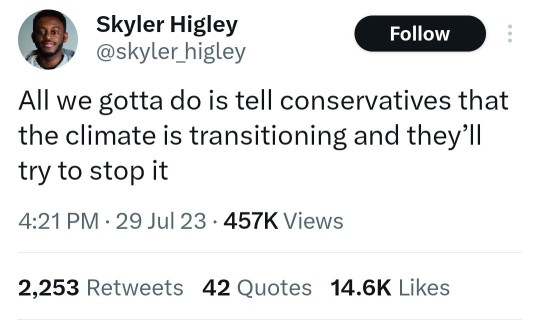
#lgbtq community#lgbtqia#lgbt pride#lgbtq#nonbinary#lesbian#queer#sapphic#nonbinary lesbian#gay girls#transition#trans women#trans#transgender#hrt#transitioning#climate change#climate emergency#climate action#environment#global warming#climate crisis#climate and environment#environmentalism
14K notes
·
View notes
Text

Last call: It's the final week to apply for the American Climate Leadership Awards for High School Students! Apply by Friday, December 15, at midnight PT!
ANNOUNCING: American Climate Leadership Awards has a new category for high school students working towards local climate solutions! @ecoamerica is awarding $125K in cash prizes to student climate leaders. Apply by 12/15: https://ecoamerica.org/american-climate-leadership-awards-high-school-2024/
#ACLA24HighSchoolStudents#ACLA24#high school#high school students#school#education#climate education#environmental education#climate and education#environment and education#climate action#climate and environment#climate#climate and health#climate blog#climate change#climate justice#climate news#weather and climate#environmental news#environment#environmental awareness#environmental activism#environmental justice#environmental#environment protection#environment and health#environmental health
8K notes
·
View notes
Text


#keir starmer#leftism#socialism#ecosocialism#environment#environmetalists#climate change#climate crisis#climate#climate action#climate disaster#capitalism#anti capitalism#communism#britain
7K notes
·
View notes
Text






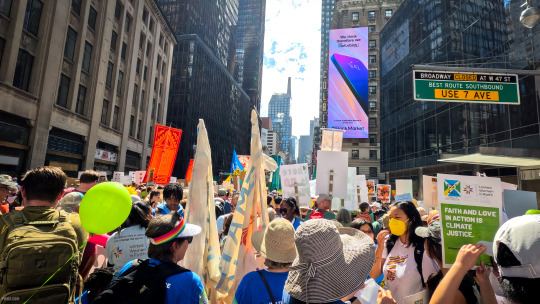
Climate Change March & Rally in New York City, September 17th, 2023.
#nyc#original photography#new york city#new york#photographers on tumblr#climate change#climate crisis#climate emergency#climate action#climate protest#global warming#fossil fuels#environment#protest#end fossil fuels#climate and environment#the lorax#lorax
2K notes
·
View notes
Text
Harrow got so unbelievablely horny dreaming about Gideon's rolled up sleeves exposing her lean, taut muscle, a little dewy with sweat and
steam but you know what.... thinking about it. Gideon does not disrobe basically ever, except in private to bathe. A tantalizing glimpse of forearm may legitimately be the most Harrow's imagination has to work with
#it takes a while for Gideon to be comfortable even removing her cloak at Canaan House#and that was a much warmer enviorment than the Ninth#kind of interesting that Gideon's seen Harrow naked and there's no evidence Harrow even knows what Gideon's shoulders look like#and how that corresponds to their different levels of emotional vulnerability#harrow laid it all out on the table: all her trauma her devotion her motivations and at the end her admiration for Gideon#meanwhile Gideon says she wants one thing then directly contradicts herself woth her actions#she flashed her heart once - you know I only care about you right? - before rolling her sleeves up and dying#this isn't a criticism of Gideon#their environment has provided a lot more security and support for Harrow#which is saying something#I also suspect she Gideon naturally has the emotional self-awareness of a cheeseburger which does not help her out but anyway#just think it's interesting how they've bared such different amounts of themselves to one another#the locked tomb#gideon nav#harrow nonagesimus
4K notes
·
View notes
Text
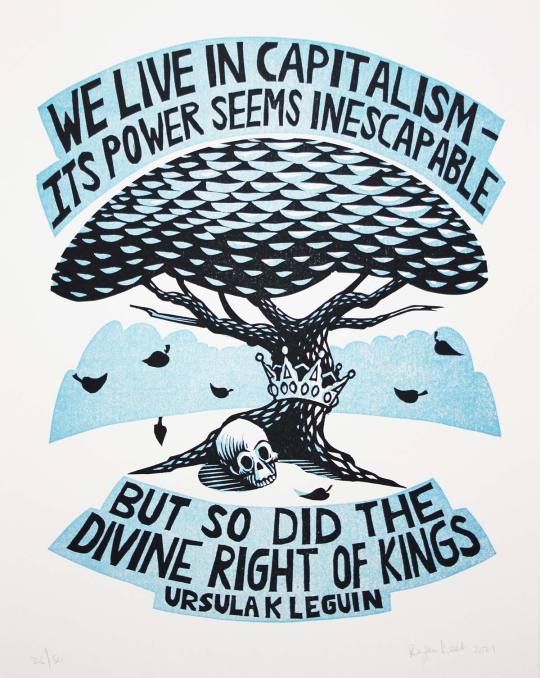
Artist credit:
#ursula k. le guin#hopepunk#hope punk#solar punk#solarpunk#futurism#climate and environment#climate action#climate hope#climate chaos#clean energy#capitalist society#capitalism#capitalist dystopia#resistance#faith in the future#economic justice#workers rights#imagine better
2K notes
·
View notes
Text
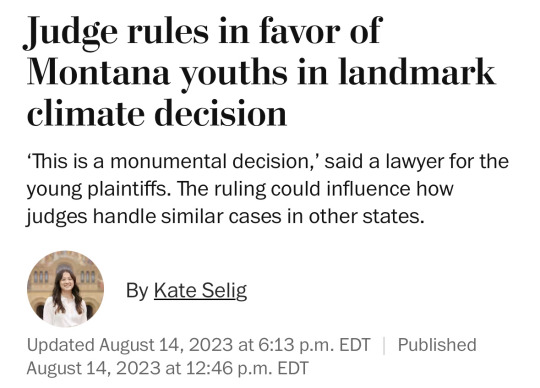
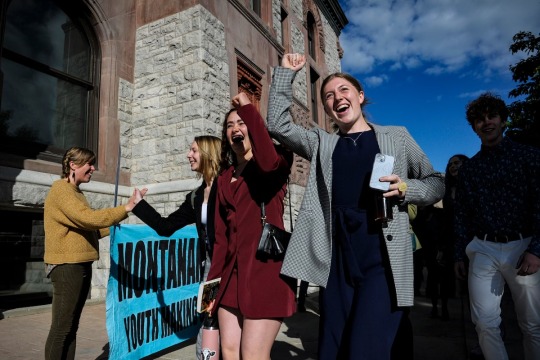

Source
Good news
#politics#us politics#government#justice#the left#progressive#climate#climate justice#montana#environmetalists#environmentalism#environment#climate activism#climate action#climate emergency#news#current events
1K notes
·
View notes
Text
#good news#environmentalism#science#nature#environment#climate change#europe#european union#climate crisis#global climate change#climate#climate action
305 notes
·
View notes
Text

That's not "irony." That's exactly the kind of shit that protesters are warning us about.
#ClimateChange #NYC #NYCFlooding
#climate change#climate crisis#climate emergency#climate action#climate and environment#ausgov#politas#auspol#tasgov#taspol#australia#fuck neoliberals#neoliberal capitalism#anthony albanese#albanese government#global warming#environmentalism#environment#enviroment art#enviromental#environmetalists#co2 emissions#co2#carbon#carbon dioxide#methane#weather#class war#anti capitalism#antinazi
501 notes
·
View notes
Text
#feminist#pattiegonia#tiktok#video#tiktoks#environment#environmetalists#save the planet#united states#trees#climate action#climate crisis#climate change#climate justice#sustainability#us goverment#forest#drag queen#conservation#us politics#stand with the trees
234 notes
·
View notes
Text
An illegal toxic dump site in Croatia, the theft of water from a major aquifer in southern Spain, illegal trading of ozone-depleting refrigerants in France: This is just a sampling of the environmental crimes that European countries are struggling to stop. The lack of accountability for these acts stems in part from the European Union’s legal code, which experts say is riddled with vague definitions and gaps in enforcement. That’s about to change.
Last week, EU lawmakers voted in a new directive that criminalizes cases of environmental damage “comparable to ecocide,” a term broadly defined as the severe, widespread, and long-term destruction of the natural world. Advocates called the move “revolutionary,” both because it sets strict penalties for violators, including up to a decade in jail, and because it marks the first time that an international body has created a legal pathway for the prosecution of ecocide.
“This decision marks the end of impunity for environmental criminals and could usher in a new age of environmental litigation in Europe,” wrote Marie Toussaint, a French lawyer and EU parliamentarian for the Greens/European Free Alliance group, on X...
The new directive uses the term “ecocide” in its preamble, but does not criminalize the act by laying out a legal definition (the most widely accepted definition of ecocide was developed by an international panel of experts in 2021). Instead, it works by providing a list of “qualified offenses,” or crimes that fall within its purview. These include pollution from ships, the introduction of invasive species, and ozone depletion...
The new law holds people liable for environmental destruction if they acted with knowledge of the damage their actions would cause. This aspect of the law is important, experts said, because it means that a permit is no longer enough for a company to avoid culpability.
“If new information shows that behavior is causing irreversible damage to health and nature – you will have to stop,” a member of the European Parliament from the Netherlands, Antonius Manders, told Euronews.
Advocates like Mehta hope that the EU’s move will have influence beyond Europe’s borders. The principal goal of the Stop Ecocide campaign is for the International Criminal Court to designate ecocide as the fifth international crime that it prosecutes, after crimes against humanity, war crimes, crimes of aggression, and genocide. At the moment, environmental destruction can only be prosecuted as a war crime at the ICC, and limitations in the law make this extremely difficult to do...
Kate Mackintosh, the executive director of the Netherlands-based UCLA Law Promise Institute Europe, told Grist that the ICC is unlikely to adopt an ecocide law if other countries do not do so first.
“It’s not something you can just pull out of thin air,” she said, adding that any international legal doctrine has to have a precedent on the national level. “That’s the way states are going to accept it.”
The EU’s 27 member states will have two years to adapt the new legislation into their penal codes. Afterwards, their implementation must be reviewed and updated at least once every five years using a “risk-analysis based approach,” to account for advancements in experts’ understanding of what might constitute an environmental crime. Mehta said that despite its omission of some important offenses, the law sets an important example for other countries. Several days before the EU vote, Belgium adapted its criminal code to include the directive, making it the first country in Europe to recognize ecocide as a crime.
The ruling “shows leadership and compassion,” Mehta said. “It will establish a clear moral as well as legal ‘red line’, creating an essential steer for European industry leaders and policy-makers going forward.”
-via Grist, March 6, 2024
#climate change#climate crisis#climate catastrophe#climate action#eu#european union#icc#international criminal court#belgium#europe#environment#environmental law#environmental news#ecocide#good news#hope#hope posting
723 notes
·
View notes
Text
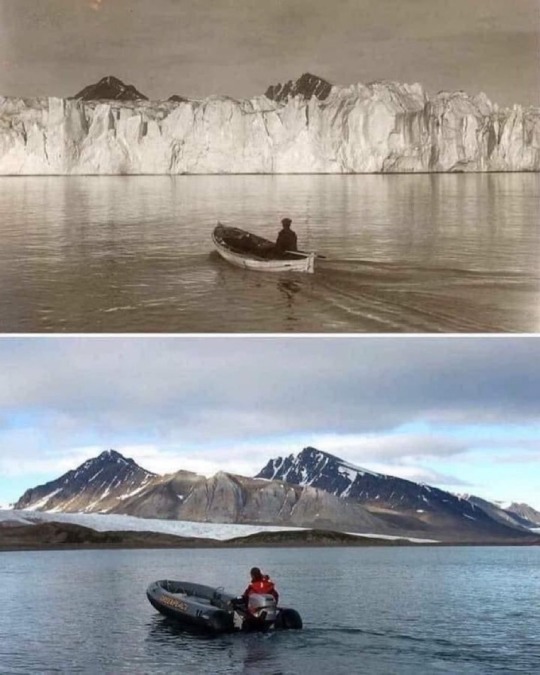
This is the same exact spot in the Arctic Ocean photographed 105 years ago vs what it looks like today. But sure, climate change is a hoax
958 notes
·
View notes
Text

Last call: It's the final week to apply for the American Climate Leadership Awards! Apply by Friday, December 15, at midnight PT!
Calling all climate leaders! 2024 marks 5 years of @ecoamerica’s American Climate Leadership Awards, and applications are open now! Your efforts toward climate solutions can earn a share of $175,000! You may be awarded $1,000 just for qualifying as a semifinalist. Apply here for your chance: https://ecoamerica.org/american-climate-leadership-awards-2024/
#ACLA24Leaders#ACLA24#climate leaders#climate solutions#climate action#climate and environment#climate#climate and health#climate blog#climate change#climate justice#climate news#weather and climate#environmental news#environment#environmental awareness#environmental justice#environmental#environment protection#environment and health#environmental health
8K notes
·
View notes
Text













Blue Eye Samurai by Jason William Scheier
#jason william scheier#blue eye samurai#animation#action series#adventure series#concept art#keyframe#environment deisgn#artwork
307 notes
·
View notes